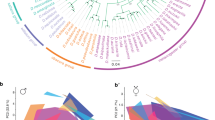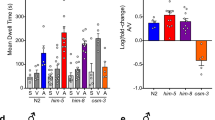Abstract
Evolution can follow predictable genetic trajectories1, indicating that discrete environmental shifts can select for reproducible genetic changes2,3,4. Conspecific individuals are an important feature of an animal’s environment, and a potential source of selective pressures. Here we show that adaptation of two Caenorhabditis species to growth at high density, a feature common to domestic environments, occurs by reproducible genetic changes to pheromone receptor genes. Chemical communication through pheromones that accumulate during high-density growth causes young nematode larvae to enter the long-lived but non-reproductive dauer stage. Two strains of Caenorhabditis elegans grown at high density have independently acquired multigenic resistance to pheromone-induced dauer formation. In each strain, resistance to the pheromone ascaroside C3 results from a deletion that disrupts the adjacent chemoreceptor genes serpentine receptor class g (srg)-36 and -37. Through misexpression experiments, we show that these genes encode redundant G-protein-coupled receptors for ascaroside C3. Multigenic resistance to dauer formation has also arisen in high-density cultures of a different nematode species, Caenorhabditis briggsae, resulting in part from deletion of an srg gene paralogous to srg-36 and srg-37. These results demonstrate rapid remodelling of the chemoreceptor repertoire as an adaptation to specific environments, and indicate that parallel changes to a common genetic substrate can affect life-history traits across species.
This is a preview of subscription content, access via your institution
Access options
Subscribe to this journal
Receive 51 print issues and online access
$199.00 per year
only $3.90 per issue
Buy this article
- Purchase on Springer Link
- Instant access to full article PDF
Prices may be subject to local taxes which are calculated during checkout




Similar content being viewed by others
References
Stern, D. L. & Orgogozo, V. Is genetic evolution predictable? Science 323, 746–751 (2009)
Chan, Y. F. et al. Adaptive evolution of pelvic reduction in sticklebacks by recurrent deletion of a Pitx1 enhancer. Science 327, 302–305 (2010)
Protas, M. E. et al. Genetic analysis of cavefish reveals molecular convergence in the evolution of albinism. Nature Genet. 38, 107–111 (2006)
Woods, R., Schneider, D., Winkworth, C. L., Riley, M. A. & Lenski, R. E. Tests of parallel molecular evolution in a long-term experiment with Escherichia coli . Proc. Natl Acad. Sci. USA 103, 9107–9112 (2006)
Golden, J. W. & Riddle, D. L. The Caenorhabditis elegans dauer larva: developmental effects of pheromone, food, and temperature. Dev. Biol. 102, 368–378 (1984)
Stiernagle, T. Maintenance of C. elegans. WormBook (ed. The C. elegans Research Community) 10.1895/wormbook. 1.101.1 (11 February 2006); available at http://www.wormbook.org
McGrath, P. T. et al. Quantitative mapping of a digenic behavioral trait implicates globin variation in C. elegans sensory behaviors. Neuron 61, 692–699 (2009)
Szewczyk, N. J., Kozak, E. & Conley, C. A. Chemically defined medium and Caenorhabditis elegans . BMC Biotechnol. 3, 19 (2003)
Viney, M. E., Gardner, M. P. & Jackson, J. A. Variation in Caenorhabditis elegans dauer larva formation. Dev. Growth Differ. 45, 389–396 (2003)
Golden, J. W. & Riddle, D. L. A pheromone influences larval development in the nematode Caenorhabditis elegans . Science 218, 578–580 (1982)
Butcher, R. A., Ragains, J. R., Kim, E. & Clardy, J. A potent dauer pheromone component in Caenorhabditis elegans that acts synergistically with other components. Proc. Natl Acad. Sci. USA 105, 14288–14292 (2008)
Jeong, P. Y. et al. Chemical structure and biological activity of the Caenorhabditis elegans dauer-inducing pheromone. Nature 433, 541–545 (2005)
Srinivasan, J. et al. A blend of small molecules regulates both mating and development in Caenorhabditis elegans . Nature 454, 1115–1118 (2008)
Bargmann, C. I. & Horvitz, H. R. Control of larval development by chemosensory neurons in Caenorhabditis elegans . Science 251, 1243–1246 (1991)
Kaplan, J. M. & Horvitz, H. R. A dual mechanosensory and chemosensory neuron in Caenorhabditis elegans . Proc. Natl Acad. Sci. USA 90, 2227–2231 (1993)
Hilliard, M. A. et al. In vivo imaging of C. elegans ASH neurons: cellular response and adaptation to chemical repellents. EMBO J. 24, 63–72 (2005)
Fodor, A., Riddle, D. L., Nelson, F. K. & Golden, J. W. Comparison of a new wild-type Caenorhabditis briggsae with laboratory strains of C. briggsae and C. elegans. . Nematologica 29, 203–216 (1983)
Cutter, A. D. Divergence times in Caenorhabditis and Drosophila inferred from direct estimates of the neutral mutation rate. Mol. Biol. Evol. 25, 778–786 (2008)
Thomas, J. H. & Robertson, H. M. The Caenorhabditis chemoreceptor gene families. BMC Biol. 6, 42 (2008)
Kim, K. et al. Two chemoreceptors mediate developmental effects of dauer pheromone in C. elegans. . Science 326, 994–998 (2009)
Nei, M., Niimura, Y. & Nozawa, M. The evolution of animal chemosensory receptor gene repertoires: roles of chance and necessity. Nature Rev. Genet. 9, 951–963 (2008)
Waters, C. M. & Bassler, B. L. Quorum sensing: cell-to-cell communication in bacteria. Annu. Rev. Cell Dev. Biol. 21, 319–346 (2005)
Hu, P. J. Dauer. WormBook (ed. The C. elegans Research Community) 10.1895/wormbook.1.144.1. (8 August 2007) available at http://www.wormbook.org.
Sucena, E., Delon, I., Jones, I., Payre, F. & Stern, D. L. Regulatory evolution of shavenbaby/ovo underlies multiple cases of morphological parallelism. Nature 424, 935–938 (2003)
Kim, U. K. et al. Positional cloning of the human quantitative trait locus underlying taste sensitivity to phenylthiocarbamide. Science 299, 1221–1225 (2003)
Yokoyama, S. Molecular evolution of vertebrate visual pigments. Prog. Retin. Eye Res. 19, 385–419 (2000)
de Bono, M. & Bargmann, C. I. Natural variation in a neuropeptide Y receptor homolog modifies social behavior and food response in C. elegans. . Cell 94, 679–689 (1998)
Hilliard, M. A., Bargmann, C. I. & Bazzicalupo, P. C. elegans responds to chemical repellents by integrating sensory inputs from the head and the tail. Curr. Biol. 12, 730–734 (2002)
Chronis, N., Zimmer, M. & Bargmann, C. I. Microfluidics for in vivo imaging of neuronal and behavioral activity in Caenorhabditis elegans . Nature Methods 4, 727–731 (2007)
Tian, L. et al. Imaging neural activity in worms, flies and mice with improved GCaMP calcium indicators. Nature Methods 6, 875–881 (2009)
Butcher, R. A., Fujita, M., Schroeder, F. C. & Clardy, J. Small-molecule pheromones that control dauer development in Caenorhabditis elegans . Nature Chem. Biol. 3, 420–422 (2007)
Butcher, R. A., Ragains, J. R. & Clardy, J. An indole-containing dauer pheromone component with unusual dauer inhibitory activity at higher concentrations. Org. Lett. 11, 3100–3103 (2009)
Li, H., Ruan, J. & Durbin, R. Mapping short DNA sequencing reads and calling variants using mapping quality scores. Genome Res. 18, 1851–1858 (2008)
Weber, K. P. et al. Whole genome sequencing highlights genetic changes associated with laboratory domestication of C. elegans. . PLoS ONE 5, e13922 (2010)
Broman, K. W., Wu, H., Sen, S. & Churchill, G. A. R/qtl: QTL mapping in experimental crosses. Bioinformatics 19, 889–890 (2003)
Chalasani, S. H. et al. Dissecting a circuit for olfactory behaviour in Caenorhabditis elegans . Nature 450, 63–70 (2007)
Acknowledgements
We thank N. Lu for the LSJ2 strain, M. Rockman for a qgIR1(X,CB4856>N2) introgression strain, J. Ragains for ascaroside synthesis, H. Hang for assistance in purifying pheromones and S. Dewell, K. Foster, N. Ringstad, A. Bendesky, Y. Saheki, M. Zimmer, S. Crosson, E. Feinberg, E. Toro, M. Rockman and L. Kruglyak for comments and advice. P.T.M. was funded by a Damon Runyon Fellowship. Y.X. was supported by Medical Scientist Training Program (MSTP) grant GM07739 and a Paul and Daisy Soros Fellowship. J.L.G. was an HHMI fellow of the Helen Hay Whitney Foundation and is funded by National Institutes of Health (NIH) K99 GM092859. R.A.B. is supported by R00GM87533. C.I.B. is an investigator of the Howard Hughes Medical Institute. This work was supported by the HHMI.
Author information
Authors and Affiliations
Contributions
P.T.M. and C.I.B. designed and interpreted experiments and wrote the paper. P.T.M. performed all genetic, molecular and behavioural experiments, Y.X. conducted calcium imaging experiments, M.A. identified the dauer-formation defect in the LSJ2 lineage, R.A.B. characterized and synthesized ascarosides and J.L.G. contributed reagents.
Corresponding author
Ethics declarations
Competing interests
The authors declare no competing financial interests.
Supplementary information
Supplementary Information
The file contains Supplementary 1-5 with legends and additional references. (PDF 964 kb)
Supplementary Table 1
This file contains genotyping data for 94 recombinant inbred lines (RILs). Figure S1 contains a schematic of how these RILs were created. (XLS 1316 kb)
Supplementary Table 2
This file contains a list of all the SNPs identified using next-generation of sequencing for a variety of strains. See Figure 1b for a description of the lineages referenced within this file. (XLS 86 kb)
Supplementary Table 3
This file contains a list of all the insertions and deletions identified in either the LSJ2 or the N2 lineage. (XLS 41 kb)
Rights and permissions
About this article
Cite this article
McGrath, P., Xu, Y., Ailion, M. et al. Parallel evolution of domesticated Caenorhabditis species targets pheromone receptor genes. Nature 477, 321–325 (2011). https://doi.org/10.1038/nature10378
Received:
Accepted:
Published:
Issue Date:
DOI: https://doi.org/10.1038/nature10378
This article is cited by
-
Pathogenic bacteria modulate pheromone response to promote mating
Nature (2023)
-
On the role of dauer in the adaptation of nematodes to a parasitic lifestyle
Parasites & Vectors (2021)
-
A mutational hotspot that determines highly repeatable evolution can be built and broken by silent genetic changes
Nature Communications (2021)
-
Transcriptional profiles in Strongyloides stercoralis males reveal deviations from the Caenorhabditis sex determination model
Scientific Reports (2021)
-
Endocrine pheromones couple fat rationing to dauer diapause through HNF4α nuclear receptors
Science China Life Sciences (2021)
Comments
By submitting a comment you agree to abide by our Terms and Community Guidelines. If you find something abusive or that does not comply with our terms or guidelines please flag it as inappropriate.



